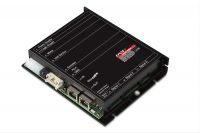Maxon Releases Latest Positioning Controller

The digital positioning controller EPOS3 70/10 EtherCAT meets the highest demands in real-time positioning of synchronized multi-axis systems. Extremely compact in size, the EPOS3 possesses a wide nominal power supply voltage range from 11 to 70 VDC and delivers a continuous output current of 10 A, during acceleration and deceleration even up to 25 A. Designed for DC brushed and brushless motors with a power range up to 700 Watt. It provides outstanding uniform running for motors equipped with incremental encoders.
Maxon’s EPOS3 70/10 EtherCAT easily integrates as slave into real-time EtherCAT protocol-based Ethernet networks. A multitude of operating modes allows efficient, flexible use in a wide range of drive systems in robotics, automation, and mechatronics. The positioning controller supports a broad bandwidth of encoders.
In the typical EtherCAT, the EtherCAT master calculates the trajectory points and sends the target parameters cyclically and synchronous via EtherCAT network to the EPOS3. The corresponding control loops for position, speed, and torque/current take place in the EPOS3 and then delivers the measured actual values (position, speed, current) to the EtherCAT master.
For the actual drive control, the EPOS3 70/10 EtherCAT is equipped with superb motion control functionality. Additional features include speed control with given target velocity to a defined mechanical position using numerous implemented methods is available. The same applies for the generous number of inputs and outputs, which makes the extra EtherCAT I/O module obsolete. Digital inputs/outputs (11/5) can be configured as reference or limit switch as well as Capture or Trigger, or can be used to activate holding brakes with definable ON/OFF switching delays. Additionally, analog inputs/outputs (2/1) are at free disposal. Perfectly tailored for servo motors, the EPOS3 70/10 EtherCAT offers built-in motor filters with motor chokes for EMC-conform operation.
The controller offers comprehensive circuitry against overcurrent, excess temperature, undervoltage and overvoltage, against voltage transients and against short-circuits in the motor cable. Furthermore, it is equipped with adjustable current limitation to protect motor and load as well as protected digital inputs and outputs.





